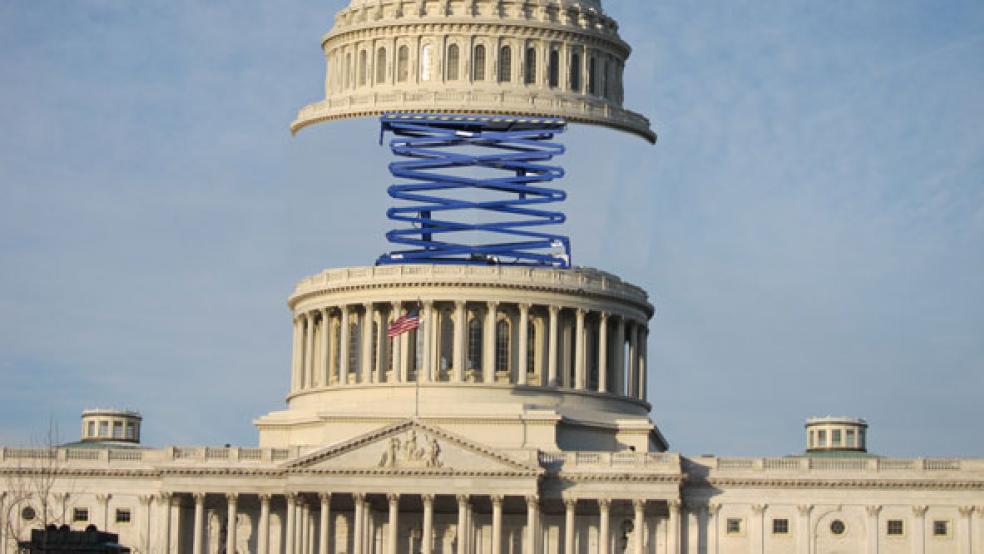What exactly does the term debt ceiling mean, anyway?
While lawmakers struggled on Wednesday to button up an eleventh-hour bipartisan deal to end the government shutdown and avert a default on the nation’s debts, here is some clarification:
What is the debt ceiling?
It’s another word for the debt limit. The debt ceiling is the amount of gross debt the federal government can have. The current limit is $16.7 trillion, which the government actually surpassed earlier this year: Its total outstanding debt is $16.75 trillion.
Since then, the Treasury has been using complicated bookkeeping maneuvers, or extraordinary measures, to acquire funds to meet its existing obligations without breaching the legal debt limit. Those obligations include Social Security and Medicare benefits, military salaries, interest on the national debt and more. But these extraordinary measures are merely to bide time.
Treasury Secretary Jack Lew warned that the extraordinary measures would only last until Thursday, October 17, when the government needed to raise its debt ceiling to meet obligations. If Friday, Oct. 18, rolled around without a deal in place, a default could have potentially put the country back into recession, rattled the markets and reverberated throughout the global economy.
Treasury would still have had roughly $30 billion to continue paying some of its financial obligations – but if it missed bondholder payments in the coming weeks, that’s when things would have gotten truly difficult.
How is the debt ceiling actually raised?
The debt limit is written into law. Any increases must be codified in new legislation by Congress and signed by the president.
What if Congress fails to raise the debt ceiling?
If the debt ceiling isn’t raised by the time extraordinary measures are exhausted, the nation would be unable to borrow any more money to pay for its existing financial commitments, which were already agreed to by Congress and the president.
What if the government defaults?
A default occurs when the government does not have enough funds to meet its legally mandated fiscal obligations. A default could potentially wreck the government’s credit rating, lower demand for U.S. assets, deprive federal workers of their salaries and deny Social Security benefits to retirees, among other things. There are actually three times in the past when the U.S. could be seen to have defaulted on its obligations, in 1790, 1933 and 1971.
How many times has the debt ceiling been raised before?
So many times it’s hard to keep track. The government first enacted the limit in 1917 in order to issue bonds during WWI. Since 1960, Congress has voted 78 separate times to raise, temporarily extend, or revise the definition of the debt limit – 49 times under Republican presidents and 29 times under Democratic presidents. The new deal on Wednesday - which would keep the government afloat until Feb. 7 - would make that 79 times.
Does raising the debt ceiling actually increase our debt?
No, it does not increase our debt.
At a press conference earlier this month, President Obama said, “It [raising the debt ceiling] does not grow our deficits. It does not allow for a single dime of increased spending. All it does is allow the Treasury Department to pay for what Congress has already spent.”
Is it really as simple as that?
No, it isn’t. PolitiFact.com, in an effort to provide further context on the issue, added this clarification to what the president said:
“Obama is correct that the debt ceiling addresses debt, not spending – at least not directly. Raising the debt ceiling allows the United States government to borrow funds that cover the obligations the government has already incurred. It doesn’t by itself prompt any new spending: Congress and the president must separately sign off on any new federal spending commitments. Put simply, the United States has chosen to divorce spending and financing decisions.
The part where Obama is somewhat misleading is when he says that raising the debt ceiling "does not allow for a single dime of increased spending." (We asked the White House for comment but didn't hear back.)
In fact, raising the debt ceiling is a necessary condition for eventually raising spending without a default. Spending can only be raised in the future if the debt ceiling is raised (or if progress is made on paying down the existing debt, something that’s rarely happened in recent decades). Without a debt ceiling hike, Congress and the president would find their hands tied if they ever wanted to make any new financial commitments.
So, contrary to what Obama said, if the debt ceiling is raised high enough, it does, in fact, “allow” for additional spending. It just doesn’t demand it.
This article was updated on Wednesday, Oct. 16, 2013, at 4:30 p.m.





